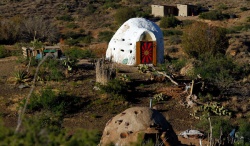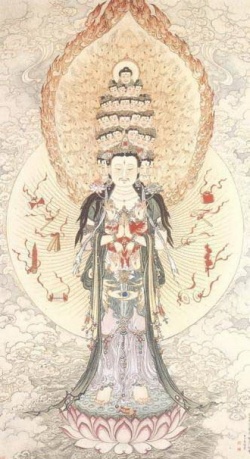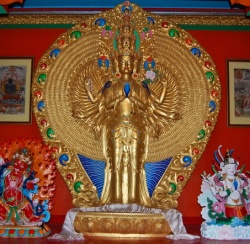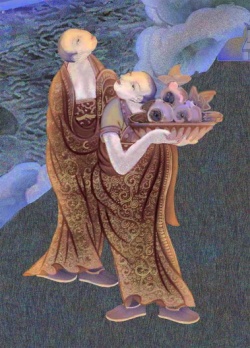Non-Death Yoga
The Non-Death Yoga is based upon the Chaja Chimbo. This is the Great Symbolism. To understand the Great Symbolism we must clearly comprehend Buddhist philosophy. In the world there are two great philosophic divisions: one is the philosophy of materialism, the other is the philosophy of spiritualism. Buddhist philosophy, however, belongs to neither of these schools. Rather, Buddhists maintain that there is no difference between spiritualism and materialism.
In Buddhist Tantra "Lung-Hsin Ne-Mae" is practiced. Lung means energy or breathing (Wisdom breathing). Hsin means mind. Non-Death Yoga belongs to the category of Ku-Hsin Ne-Mae. Ku means body, Hsin means mind. Here there is no difference between body and mind, they are completely identified. All one-sided views have been totally exposed.
From the Consequence (final) position of Nirvana, there is no birth and no death. This is called Seh-Ji Mae, Jeg-Ji Mae in Tibetan. Hence, we recognize three types of non-dualism: the beginning or causal position maintains that matter and mind are not different. In the intermediate or course position, we learn the practices of Lung-Hsin Ne-Mae and Ku-Hsin Ne-Mae. Lung-Hsin Ne-Mae is the practice of the second and third initiations. There, mind and energy are identified which gives birth to the experience that mind and body are not different. This is Ku-Hsin Ne-Mae. Hence the advanced stages of Ku-Hsin Ne-Mae is in the Consequence (final) position. Non-Death Yoga is a practice of the Consequence position giving birth to the full Enlightenment of Nirvanano death, no birth. A Chinese explanation is that Nir means no birth, Vana means no death. Thus, Nirvana is non-death, is full Enlightenment, is non-birth and non-death.
The ten Dharmadhatus are based upon the background of three principles: Materialism, Spiritualism and Non-duality (birth, death, spiritualism, and materialism are identified and harmonized).
1. The lowest dharmadhatu is the hell realm. Here the one-sided view of materialism sinks one into great torment. The greater the attachment and paranoia for material security, the deeper one falls. Just as a piece of wood will float on top of the water, a stone will sink directly to the bottom of the ocean. Mao Tze Tung and his followers kill, rape and burn China and its people, attempting a material solution to suffering, thus they have no satisfaction. They will continue to kill, rape and burn until they drop their materialistic view. Now they kill not only their enemies, Mao has even had Lin Piao killed who was his close friend. Next it will be Chou-En Lai, and by and by Mao will even kill his wife. This is the fruit of the one-sided view of materialism. I regret to say that many American youths have not discovered the non-dualistic view, and now search for liberation and freedom by adopting Maos materialistic mania. But history and current crises have proven several times over that no political party, sect, cult, etc., can sever the bondage of mans inner sorrow. No cheap politician could ever entice those individuals of altruistic action and intention to follow him. Such individuals are bent upon genuine liberation; they see politics for what it is: the gateway to ego-hood, cruelty, treachery, hypocrisy and lunacy. This is the hell realm of extreme materialism, the paradise of Mao, Hitler and Stalin. These individuals are perhaps demonic, but definitely not humane. There is no one sincerely engaged upon the path of human fulfillment who does not see through these charlatans in political disguise. Remove the mask and expose the dharmadhatu of these grotesque hell beings. A Buddhist practitioner sees that such hell beings are not engaged for the benefit of mankind, but for profit, fame, wealth, power, and all other forms of materialism.
2. Next is the ghost dharmadhatu. It is a little better than the hell realm because its beings were not as cruel as those who fell into hell. But still they have a hunger for gross materialism and are very selfish. They want to share their food with no one, and have ravenous appetites. Hungry ghosts are portrayed with a huge stomach and an extremely thin neck; they are insatiable because the thin neck does not permit food to enter the large stomach. The large belly is the reward for those persons who are extremely possessive. They want it all for themselves, they do not want to share even a small crumb with others. There are many hungry ghosts with human bodies. They have no Bodhicitta. Even in a spiritual organization, one can find several prominent hungry ghosts, whose wealth, knowledge, etc. is just for the glorification of their own ego, rather than sharing with others. This is the dharmadhatu of the hungry ghost.
3. The animal dharmadhatu is higher than the ghost because its beings are a little more generous. Also, they fulfill some function in helping others. The ox plows the fields, the cat drives away mice, the bee makes honey, the pig offers its flesh and the dog will guard your door. So the animal has a little tiny bit of spiritualism; but when it comes to eating food, the parents will fight their children over a tiny morsel. The love of food is still much greater than the love of even their own family. This is the animal realm.
The above are the lower three realms, henceforth the materialism is less and spirituality increases.
4. The next state is the dharmadhatu of man. It lies midway between materialism and spiritualism, between Buddhism and non-Buddhism. It is the best position from which to develop Buddhahood. Within the human realm all ten dharmadhatus are manifested. A man may become an asura, arhat, God, Bodhisattva or Buddha. Likewise, a man may fall into the three lower states of hell, ghost, or animal. For instance, Mao is in a human body but in fact he lives in the hell realm. So do not be fooled by external facades; we can observe the class of beings by the quality and altruism of their activity. The human realm is analogous to a bridge from which one may pass to the shore of Godhood, or to the three lower states. Beyond both shores lies Buddhahood. Man has a wide spectrum from which to choose, a rich and versatile position indeed.
5. Above the human realm is the asura dharmadhatu; these beings have done numerous good deeds when they were in the human realm but did them with excessive envy and anger toward God. This extra envy prevents them from entering the territory of the gods. They usually fight with God.
6. Next is the heaven dharmadhatu. The first kind is the heaven of desire. Their good deeds were done with humility and free from envy. Unfortunately, they colored their deeds with the desire for materialism in a delicately subtle fashion. They are above the asura because they do not have envy; thus they never fight amongst each other or cause wars. Gods are almost completely free from envy so their food is very easy to obtain. Whenever they want to eat, food automatically comes to them. It is not necessary to go to a Chinese restaurant or engage a cook. Whatever he thinks just naturally comes to him. Surely their spiritualism is much more than the asuras.
The second kind of heaven is the heaven of form. The subtle desire for materialism in the heaven of desire is refined even more. These gods do not desire to eat food at all. They love to see the form of spiritual beings. Therefore they have not yet freed themselves from the subtle materialism. We might say that they "eat" spiritual food of the form with their eyes or mind. When there is no materialism, there is no form. But these gods feast their eye of consciousness on all sorts of lights, spiritual forms, divinations, and other beautiful sights. Their spiritualism is more than those of the heaven of desire.
The third kind is heaven of non-form. The gods indulge in a purely spiritual meditation-light without form. This is the highest form of meditation of the high self of Hinduism or Taoism. The sages of these traditions do not go beyond this point. If we wish to go further we must utilize the vehicle of Buddhism. Buddhists maintain that this refined meditative light is still within the realm of spiritualism and subtle materialism. This light must be gnosticized by the Sunyata before it is entirely free. Hindus fail to realize this and fall into the duality of God and his meditative light as being separate entities. This is merely the highest and most subtle discrimination between spirituality and materiality. Buddhist eliminates this dichotomy with the Sunyata of non-self meditation. Thus, Buddhahood is complete liberation. All these previous six (three kinds of heaven are included) dharmadhatus still remain within the transmigration (world of suffering). Buddhism harmonized spiritualism and materialism, and gnosticizes them and sublimates them with Sunyata. Thus there is non-spiritualism, non-materialism. But the facts of materialism and spiritualism from mans viewpoint of the world are still there. Thus from the positive Buddhist viewpoint spiritualism and materialism are harmonized, sublimated, and gnosticized by the meditation of Sunyata.
7. In the Arhat dharmadhatu, there is non-materialism and non-spiritualism. He wants to subdue his personality and harmonize with the surroundings of his meditative environment. However, he leaves out negative (evil) dharmas; he purposely avoids them, thus, his non-dualism is limited. He knows the non-self of personality; he also knows a little non-self of dharmas. But he is very frightened of evil dharmas, so cannot penetrate them. Consequently, his harmonization is limited. His Nirvana is called Nirvana with something remaining. Something remains outside of his samadhi. However, this part that remains can not cause him to fall. Unfortunately, he does not use the vajra force to save persons in evil conditions, so we call it Hinayana meaning small heart.
8. The Bodhisattva dharmadhatu has ten stages. They see all dharmas as Sunyata because their view is vast and panoramic. They try to penetrate all evil dharmas to save sentient beings. Some of them achieved a partial Sunyata, while others may not be strong enough to penetrate the evil dharmas so they are purposefully reborn again and again. Many have been in the human state for as long as three kalpas. Still they never give up. But they should return to the meditation seat to make their Sunyata force sharper and more powerful in order to penetrate the evil dharmas fully. Then they can save sentient beings possessing the five poisons of materialism (lust, anger, doubt, pride, and ignorance).
9. Above the four degrees of Arhat, there is the Hinayana Buddha: His meditative force is more complete than the fourth stage Arhat. But he does not attempt to use it to work in the lower realms. But only the Buddha can move the Hinayana Buddha out of his Samadhi. Even a Bodhisattva can not move him.
10. The fully enlightened Buddhas have the Samadhi of complete harmonization of dharmas in Sunyata, but he also has the complete supernatural power to save all sentient beings in all realms. This especially includes those who have fallen into the lower realms. The above ten dharmadhatus are a manifestation of the function of materialism or spiritualism or the non-dualism of these two.
The Non-Death Yoga is based upon the final achievement of the non-dualism of the Great Perfection or Great Symbolism. Now I will translate the original non-death yoga text imparted to me by Kalu Rinpoche:
First, one should get the initiation from a Guru and complete the preliminary practices. The text in Chinese translated from Tibetan is hereby rendered in English as follows:
One must visualize oneself as the yidam. The yidam must be a heruka. The heruka must surely embrace his dakini. One should first try to distinguish whether the heruka and dakini are identical to the mind or are different. If they are different, then when mind contains some delusions, where do they come from? Also, where do the delusions disappear to? If they remain, where is it that they remain?
Is the body identical to the yidam? or is the body identical to the mouth? Or is the body identical to the mind? Or is the dakini identical to the mind? If the yidam and dakini are identical to the mind, besides the mind is there any other mind? If the yidam and dakini together are not identical with the mind, then is either one of them, alone, identical with the mind? or are both not identical with the mind?
If both are not identical to the mind, then when we visualize the yidam with the mind, is this visualization inside or outside of the mind? Or in between the yidam and the mind?
The above practice is much more than intellectual conceptualization; one must experience the realization. If we have mind, then we can visualize the yidam. If there is no mind, then who can visualize the yidam?
Suppose we have determined that there is a mind. If mind has death, then in what manner and by what method is this process undergone? There is no such process which we have seen or heard as death of mind. This is the determination of the non-death of the mind.
When mind is non-death, does the body still die? Since the body is visualized as the yidam by the mind, then if mind is non-death, how can the body die? If the flesh body dies, the mind in the bardo state visualizes the yidam which is the Sunyata light body and arises again. How can this Sunyata body die? Therefore, we may conclude that because the mind is non-death, the body is also non-death. One must have this determination of mind and body identification.
Again, when we visualize the yidam with all his gestures, ornaments, clothes, etc. it seems as if something is there. But this something has no more substance than a dream. One may dream of a house, occupied with people, some playing, some quarreling, some ill, but when we awake, we feel that there is nothing at all. The yidams are visualized in this dream-like manner. They are merely mind-made projections, phantoms.
In order to know there is non-death or to visualize the body as non-death, we must have the determination that mind is the yidam, body is the mind; therefore both body and mind are non-death. This is more than mere conception, one must have the meditative force to get the realization of this great tantric fact.
Again, if mind is Sunyata there is no birth, no abiding, no destruction; hence mind cannot die; therefore, body cannot die. The mind has no birth, no death, no abiding. The yidam is identical to the mind in all activitywalking, standing, sitting, sleeping, etc. They are never separate. Because the mind has no death, the yidam body also has no death.
This is the end of the original translation.
Now I will give a summary of the original text, consisting of 9 steps:
- Visualize the yidam and dakini.
- Visualize whether the yidam body and the mind are identical or different.
- Try to determine if the yidams mind is outside or inside or between the two.
- Try to determine if the mind has death or not.
- Try to determine if the yidam body has death or not.
- The mind is kept in the Sunyata-light and from this the yidam arises. Since this yidam body comes from the Sunyata-light, how can it die?
- Visualize the yidam body to be the same in nature as a dream. Think that the dream body has no death.
- Determine that the yidam body and the mind are identical.
- Determine that the mind is non-death, therefore the yidam body is non-death.
Next are corrections and additions regarding the Non-Death Yoga derived from my practical experiences. When practicing the non-death yoga one should not think of death. In the original text that is in bold print, it mentions that the flesh body dies, then the yidam body is born in the Sunyata light. I thought this was a mistake for all sentient beings in the transmigration to have this kind of experience. This is merely rebirth doctrine and should be eliminated when practicing the non-death yoga. One should never think that the flesh body dies. But emphasize that the body is the mind, and the mind is the body. Thus because the mind does not die, the body does not die.
An additional practice should connect with time.
Death has a corresponding relationship with time. We must make time continuous, with no past, no present, and no future. Since body and mind have no dualism, neither can there be a dualism between past and future. Today is the tomorrow of yesterday, and the yesterday of tomorrow. The three periods are in oneness. In the past there is no death; in the future there is no birth. We cannot say that the sunrise is rebirth or that the sunset is death; actually they are the same. The sun itself has not changed. But the human being always depends on the sunrise to begin his day or sunset to end the day. Actually we should not say that the past died. Sometimes I feel like I am as happy as those old ancient sages, I do not think that they have died, or that the time died, or that we are behind them. In the future there is no birth. I passed 25 years in the Kalimpong India hermitage, but it seems just like a few minutes. The three periods are always in oneness. If my meditation can enable me to abide on the oneness of the three periods, how could the body die? The mind is no death, time has no death, there is no death of yesterday. There is no birth of tomorrow. No birth of the future, no death of the past. The present is not isolated in time. Who can say which moment is the present? It is always connected with the past and the future, moment after moment. Likewise the past and the future can never be isolated. Who can say what is birth? What is death? What is abiding? All these are merely human ignorance.
There are some additional practices which I have used in my own experience.
Sometimes I visualize that my body is as vast as the Dharmakaya and this visualization of Dharmakaya is made by my mind. So how can this body die? If this Dharmakaya dies, where would we bury this great corpse? Sometimes I visualize my yidam body being as small as a particle of dust or as fine as the hair of a horse tail. If this small body dies, how does it die?
Again when I use my mind to visualize the Dharmakaya, then his Dharma body and my mind have no differentiation. My flesh body is in the center of the Dharma body and has been visualized as a mind of wisdom lamp; then my flesh body and my visualized mind have no differentiation also. Hence there are two folds of body and mind, outwardly and inwardly. Neither of them has death. If one really follows the text and my additional practice, he will surely get the attainment of non-death yoga.





